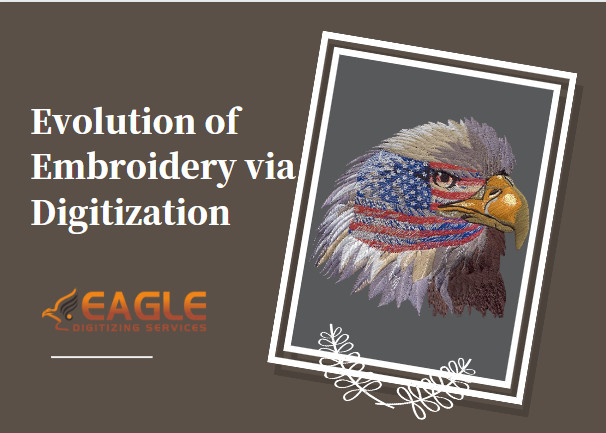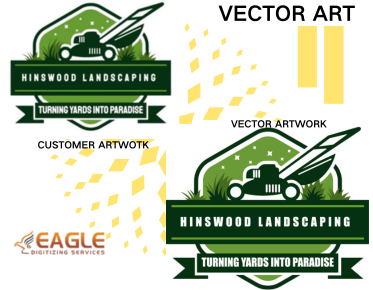Green Stitches: The Demand for Eco-Conscious Embroidery Designs
The Intersection of Art and Sustainability
Embroidery has long been considered an art form, a craft
passed down through generations, intricately weaving patterns, stories, and
history into fabric. However, as the world pivots toward sustainability, this
timeless practice is meeting the future head-on, intertwining beauty with
eco-consciousness. Eco-friendly embroidery is not just a passing trend—it's a
new lens through which we view fashion, art, and our planet's future. Let’s
explore the dynamic intersection where creativity meets sustainability and how
it’s shaping the world of design.
Why
Eco-Friendly Embroidery is More Than a Trend
Eco-friendly embroidery isn't just another fad. It's part of a larger,
ongoing cultural shift toward environmental awareness and sustainability. As
consumers demand more transparency from brands, designers are seeking ways to
minimize their environmental impact. Sustainability is no longer just a
buzzword—it’s an essential movement driving the future of fashion,
craftsmanship, and even home décor. By choosing eco-friendly materials, sustainable
dyeing methods, and low-impact stitching techniques, embroidery has found a way
to stay true to its artistic roots while meeting the modern world’s need for
sustainability.
The
Growing Consciousness Around Environmental Impact
The past few decades have ushered in an era of heightened awareness
about environmental issues. As climate change, pollution, and resource
depletion become more pressing, people are taking a closer look at the
industries that contribute to these global challenges. Fashion, notorious for
its heavy environmental toll, is undergoing a major transformation. Consumers
are not only becoming more selective about the brands they support, but they’re
also increasingly favoring products that are ethically sourced, produced with
minimal waste, and crafted with respect for nature. This shift has catalyzed
the rise of eco-conscious embroidery, a clear sign that the industry is waking
up to the environmental impact of its craft.
What is Eco-Conscious Embroidery?
Eco-conscious embroidery refers to the practice of stitching designs
using materials, techniques, and processes that prioritize sustainability and
environmental responsibility. This includes using organic and recycled fabrics,
avoiding harmful chemicals, and adopting energy-efficient methods. From the
selection of the threads to the final design, every element of eco-friendly
embroidery is thoughtfully chosen with the planet in mind. It’s embroidery with
a conscience—where creativity and sustainability coexist in perfect harmony.
Defining
Sustainable Stitches: What Does It Mean?
Sustainable stitches are more than just threads on fabric—they
represent a mindful approach to design that incorporates eco-friendly practices
at every stage of creation. Sustainability in embroidery can be defined by
several key factors: the use of biodegradable or recyclable materials, reducing
waste during the stitching process, and ensuring the products are crafted to
last. By focusing on these principles, artisans can create beautiful, long-lasting
designs without compromising the health of our planet.
How
Eco-Conscious Embroidery Differs From Traditional Techniques
Traditional embroidery often relies on materials that are not
environmentally friendly—think synthetic fibers, harmful dyes, and
mass-production methods that contribute to pollution and waste. Eco-conscious
embroidery, on the other hand, embraces sustainable materials like organic
cotton, hemp, and even recycled fabrics. In terms of techniques, sustainable
embroidery may incorporate methods that reduce water and energy consumption,
such as low-impact dyeing or digital stitching. This shift not only reduces the
ecological footprint of embroidery but also encourages a more intentional,
ethical approach to design.
The
Environmental Impact of Embroidery
Embroidery, like many aspects of the fashion and textile industries,
has a hidden environmental footprint. The production of fabrics, the use of
chemicals in dyes, and the waste generated from offcuts and unused materials
all contribute to environmental degradation. In particular, synthetic fibers
and chemical-heavy dyes are major pollutants. However, the rise of
eco-conscious embroidery is actively working to mitigate these impacts. By
embracing sustainable practices, the embroidery world can become a powerful
force for positive change in the textile industry.
The Hidden Environmental Footprint of Fashion and Textiles
Fashion, one of the most polluting industries in the world, has long
been associated with high environmental costs. The process of making fabrics,
dyeing them, and producing garments contributes significantly to water
pollution, deforestation, and carbon emissions. Eco-conscious embroidery,
however, presents an opportunity to break this cycle. By sourcing natural, organic
fabrics and opting for low-impact dyes, designers can significantly reduce the
environmental toll their creations take on the planet.
Water
Usage, Dyeing Practices, and Their Impact on the Planet
One of the biggest environmental concerns in the textile industry is
water usage. The process of dyeing fabrics consumes vast amounts of water, and
much of it becomes contaminated with toxic chemicals. Eco-friendly embroidery
addresses this issue by turning to plant-based or low-impact dyes that require
fewer resources. Waterless dyeing techniques and natural dyes not only reduce
water consumption but also eliminate the need for harmful chemicals that
pollute waterways.
How
Embroidery Can Reduce Waste in the Fashion Industry
Embroidery has the potential to reduce waste by repurposing old
garments and textiles, giving them new life through creative design. Instead of
contributing to the mountains of discarded clothing, embroidery offers a way to
upcycle, mend, and restore old fabrics. This not only prevents waste but also
encourages a more circular approach to fashion, where products are designed to
be reused, repaired, and repurposed.
The
Rise of Eco-Friendly Fabrics in Embroidery
As the demand for sustainable fashion grows, the use of eco-friendly
fabrics in embroidery has skyrocketed. Fabrics like organic cotton, linen,
hemp, and bamboo are quickly becoming the go-to choices for eco-conscious
artisans. These materials are grown with minimal use of chemicals, require less
water, and are biodegradable, making them far more sustainable than their
conventional counterparts. Furthermore, recycled fabrics—such as those made
from post-consumer plastic waste—are gaining popularity for their ability to
repurpose discarded materials into something beautiful.
Organic
Cotton, Linen, and Hemp: The Natural Choice for Threads
Organic cotton, linen, and hemp are some of the most popular
sustainable fabrics used in embroidery. These fibers are grown without the use
of pesticides or synthetic fertilizers, which helps reduce the environmental
impact of cotton farming. Hemp, in particular, is a highly sustainable crop
that requires minimal water and grows quickly, making it an ideal choice for
eco-friendly textiles. These natural fabrics also tend to be durable, ensuring
that embroidered pieces last for years to come.
Recycled
Fabrics: Giving Old Textiles a New Life
Recycling is one of the cornerstones of sustainable design, and in
embroidery, it can take on a new dimension. Recycled fabrics are made from
materials such as post-consumer plastic bottles or textile waste, giving
discarded items a second life. By using these fabrics in embroidery, designers not only reduce waste but also create
unique, one-of-a-kind pieces that tell a story of sustainability and
creativity.
The
Role of Bamboo and Other Sustainable Materials
Bamboo, with its rapid growth rate and minimal environmental impact,
is quickly becoming a sustainable alternative to conventional fabrics. Bamboo
textiles are soft, breathable, and biodegradable, making them an excellent
choice for eco-conscious embroidery. Other sustainable materials such as cork
fabric, Tencel, and organic silk are also being explored for their
environmental benefits and potential in the world of embroidery.
Sustainable
Dyeing Practices: Crafting Color Without Harm
Dyeing is one of the most resource-intensive processes in textile
production. Traditional dyeing methods often rely on toxic chemicals and
excessive amounts of water, both of which have a significant environmental
cost. However, eco-conscious embroidery embraces plant-based dyes, which are made
from natural ingredients like indigo, turmeric, and hibiscus. These dyes are
not only more environmentally friendly but also produce beautiful, rich colors
that are unique and vibrant.
Plant-Based
Dyes: A Colorful, Eco-Friendly Solution
Plant-based dyes are a natural, eco-friendly solution to the harmful
chemicals used in conventional dyeing processes. Derived from flowers, leaves,
roots, and other plant materials, these dyes are biodegradable, non-toxic, and
often require less water to produce. Eco-conscious artisans are increasingly
turning to these dyes, which offer a wide range of hues and tones, allowing for
an exciting spectrum of color without harming the planet.
The
Shift to Waterless and Low-Impact Dyeing Methods
Waterless dyeing techniques are revolutionizing the textile industry,
drastically reducing the water consumption associated with traditional dyeing
methods. These innovative processes use air or carbon dioxide to transfer color
to fabric, bypassing the need for large quantities of water. Low-impact dyeing,
which utilizes less water and energy, is also becoming more common in
eco-conscious embroidery, contributing to a more sustainable and efficient
design process.
How
Eco-Dyes Are Changing the Game in Textile Design
Eco-dyes are altering the very fabric of the textile industry. They
allow designers to create beautiful colors while minimizing the environmental
impact associated with synthetic dyes. With innovations like eco-friendly
printing and dyeing techniques, designers can now create textiles that are not
only aesthetically pleasing but also environmentally responsible. This change
is paving the way for a future where fashion is both beautiful and sustainable.
Eco-Conscious Threads and Their Impact on the Environment
The choice of thread is another critical aspect of eco-conscious
embroidery. Traditional synthetic threads, often made from petroleum-based
materials like polyester, contribute to environmental degradation. In contrast,
eco-friendly threads made from organic cotton, hemp, and even recycled
materials are both sustainable and durable. These threads, free from harmful
chemicals and pollutants, help reduce the overall environmental impact of
embroidery and contribute to a more sustainable fashion industry.
The
Shift to Organic and Biodegradable Threads
As the demand for sustainable fashion grows, so too does the shift
toward organic and biodegradable threads. These threads, made from natural
fibers like cotton and hemp, decompose naturally and leave behind minimal
waste. In addition, they are often produced using less water and fewer
chemicals, making them a far more eco-friendly choice than conventional
synthetic threads.
Avoiding
Synthetic Fibers: The Case for Eco-Friendly Threads
Synthetic fibers like polyester, nylon, and acrylic are ubiquitous in
the fashion industry, but their environmental impact is staggering. These
materials are non-biodegradable, contributing to landfill waste, and their
production relies heavily on fossil fuels. By choosing eco-friendly threads
made from organic or recycled materials, designers can help mitigate the
environmental damage caused by synthetic fibers and promote a more sustainable
approach to fashion and embroidery.
How
Ethical Brands Are Sourcing Their Materials
Ethical brands are taking a more transparent approach to sourcing
their materials. They are choosing suppliers who prioritize sustainability,
fair trade practices, and eco-friendly production methods. These brands
understand that consumers are increasingly aware of the environmental and
social impact of their purchases, and they are working to ensure their
materials come from responsible sources. This commitment to ethical sourcing
helps foster a more sustainable and socially conscious embroideryindustry.
How
Eco-Conscious Embroidery Benefits Artisans and Local Communities
Eco-conscious embroidery not only benefits the environment but also
supports small-scale artisans and local communities. By prioritizing
sustainable materials and fair trade practices, designers can help empower
artisans in developing regions. These artisans are often able to earn a fair
wage while working in safe conditions, and they gain access to markets that
appreciate their craft and sustainability efforts. Through eco-conscious
embroidery, we create a cycle of support and empowerment that uplifts both
people and the planet.
Supporting
Small-Scale Artisans: The Social Impact of Sustainable Practices
Small-scale artisans often face significant challenges, such as low
wages, limited resources, and lack of access to larger markets. Eco-conscious
embroidery provides a way for these artisans to showcase
their talent while earning fair compensation. By choosing sustainable materials
and ethical production practices, designers are helping to create a more
equitable and inclusive global market that supports the livelihoods of artisans
and their communities.
Fair
Trade and Ethical Practices in Embroidery Design
Fairtrade and ethical practices are central to the philosophy of
eco-conscious embroidery. Fairtrade ensures that artisans receive a fair wage
for their work and that their labor conditions meet specific social and
environmental standards. By integrating fair trade principles into embroidery design, brands and consumers alike can
play a role in supporting ethical practices that contribute to the well-being
of workers and the environment.



